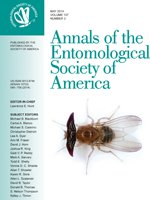The association of insect-resistant plants with biological control is important in integrated management to reduce the density of pests below the economic injury level. The behavior, development, and predation of Podisus nigrispinus (Dallas, 1851) (Heteroptera: Pentatomidae) were studied with the prey Spodoptera frugiperda (J. E. Smith, 1797) fed on the leaves of the cotton cultivars ‘NuOpal’ (transgenic), ‘DeltaOpal,’ ‘FMX910,’ ‘FMX993,’ or ‘FMX996′ (conventional). The attraction of P. nigrispinus to S. frugiperda larvae fed on different cotton cultivars was similar. The predation of nymphs and adults, and the life cycle of the P. nigrispinus predator were higher for S. frugiperda larvae fed on the NuOpal; however, the total viability of P. nigrispinus was lower when predating on S. frugiperda fed the NuOpal. S. frugiperda acquires toxins from transgenic cotton, which can affect its natural predator P. nigrispinus.
How to translate text using browser tools
1 May 2014
Behavior, Development, and Predation of Podisus nigrispinus (Hemiptera: Pentatomidae) on Spodoptera frugiperda (Lepidoptera: Noctuidae) Fed Transgenic and Conventional Cotton Cultivars
Flávio G. De Jesus,
Arlindo L. Boiça Junior,
Gleina C. S. Alves,
José C. Zanuncio
ACCESS THE FULL ARTICLE
It is not available for individual sale.
This article is only available to subscribers.
It is not available for individual sale.
It is not available for individual sale.
armyworm
biological control
plant resistance
predator
Tritrophic interaction





